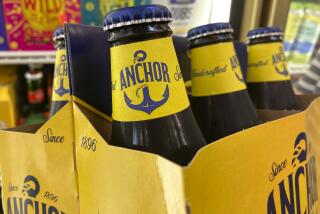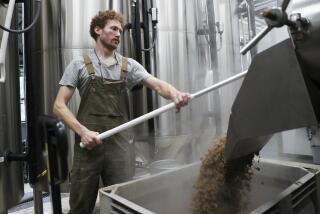Special Ale Provided Initial Yeast for Rising Success of Brew Pubs
- Share via
YAKIMA, Wash. — Bert Grant just wanted a decent beer.
So he mixed two different malts, a special ale yeast hybrid he isolated and fresh hops to create a beer that pleased his palate.
Then he offered it repeatedly to decision-makers at the major breweries where he worked in the 1940s, ‘50s and ‘60s.
“They said it tasted great, but no one would buy it,” Grant, 69, said with a chuckle.
Finally, 15 years ago, he began brewing it in commercial quantities himself.
That was the beginning of Grant’s Scottish Ale, a beer Grant brags is the best in the world. It is the flagship brew of Yakima Brewing & Malting Co. and of Grant’s Pub--the first post-Prohibition brew pub in America.
Before 1982, when the pub opened here, federal and state laws prohibited the sale of beer where it was brewed, said Craig Bystrynski, editor of the trade magazine BrewPub.
“The whole structure after Prohibition was very odd and cumbersome. It started with the idea that drinking is evil and it must be regulated in the strictest way possible, otherwise the people who make alcoholic beverages will abuse the system,” Bystrynski said.
Federal laws were changed in the 1970s after strong lobbying, and states slowly followed suit. Brew pubs are still illegal in Mississippi and Montana.
Bystrynski considers Grant the trailblazer for a booming industry that has mushroomed to 1,400 brew pubs across the country, with the largest number in the Pacific Northwest, California and Colorado.
“I think what happened was brew pubs followed a trend that’s a major cultural trend in America,” Bystrynski said.
“It’s a trend toward flavor, a trend toward more variety. People are demanding more when they go to restaurants, when they drink wine and when they drink beer. Brew pubs are a natural development.”
Born in Dundee, Scotland, and reared in Toronto, Grant got his start in the beer industry at age 16 as an analytical chemist at Canadian Breweries Ltd. in Toronto. He had two job offers when he graduated from a technical high school shortly before the end of World War II--to work as a gold assayer or learn to brew beer.
Grant notes that he “could have earned much more money as a gold assayer.”
He enjoys recollections of his start almost as much as he enjoys a good pint.
“Five years before it was legal for me to drink, I was tasting 100 beers in a day. Oh, it was a terrible job, but somebody had to do it,” Grant said, a wide smile brightening his face.
“Can you imagine what my classmates thought when I went back for my graduation in June and they asked me what I was doing? ‘Oh, I have a terrible job. I have to taste 50 beers every morning.’ ”
He later worked as director of brewing research at Stroh Brewing Co. in Detroit and as a consultant to most of the world’s best-known breweries.
In 1967, he was drawn to Yakima, in the heart of the nation’s largest hop producers, where he pioneered a process of pelletizing hops--a prime ingredient of beer--to preserve their freshness.
But that wasn’t enough for him.
“I was just tired of all the regular beers and I’d been making beer in a pilot brewery to evaluate new hop varieties in my basement. So it was only a small step to go from 5 gallons to five [31-gallon] barrels.
“And that’s what we did,” Grant said.
He’s been both an example and a teacher for others who want to break into the industry.
“In our second year, 1983, at least 10% of the people coming into the brewhouse were potential competitors, people who wanted to open up their own breweries,” Grant said. “Probably two-thirds of the guys who started out between 1983 and 1986 came through Grant’s Pub to see how it was done.”
Although the market has gotten tighter for microbreweries, which have to compete for shelf space in stores and tap handles in bars, the brew-pub industry keeps growing.
“When you get down to the real heart of it, a brew pub is at its very core a bar-restaurant. What distinguishes it is the beer made on premise, but it has to operate as a fully functional bar-restaurant,” said Jim Parker, director of the American Homebrewers Assn., based in Boulder, Colo., and former director of the Assn. of Brewers in the same office.
“So anywhere that a bar-restaurant will succeed, you can put a brew pub,” Parker said.
Bystrynski agrees.
“I think the brew-pub market is definitely going to continue to boom. They’re local entities. They’re restaurants.”
Grant says quality is the key to his success. Annual production at his brewery, Yakima Brewing & Malting Co., has grown from 1,000 gallons in 1982 to 25,000 31-gallon barrels 15 years later.
“The thing I was proud of is that the first 5-barrel batch tasted the same as the last 5-gallon batch,” Grant said.
His background in brewing research taught him the importance of chemically analyzing the beer to ensure consistent quality.
“I think it’s important. It shows up in the product. You can analyze for changes and detect them much sooner than you can taste them,” Grant said.
In 1995, Grant sold both the brewery and the pub--where special batches of beer are still brewed regularly in his original five-barrel kettle--to Woodinville-based Stimson Lane, the parent company of Chateau Ste. Michelle winery, among others.
He is still chief brewer and oversees all phases of the beer-making, but the brewery needed an influx of capital to keep growing, Grant said.
“We were increasing our sales, but not really fast enough to keep up with the industry. We had to have more marketing expertise and more marketing dollars, so we decided to sell.”
He considers it an advantage to have sold to Stimson Lane rather than any of the major breweries that made him offers over the years.
“Being a winery, they’re not going to be coming in like Anheuser-Busch would come in and say, ‘Well, you could do this cheaper,’ or, ‘You could hit a wider market by doing this.’
“They just leave the beer the way it is,” Grant said.
And good beer is, of course, the most important thing.
More to Read
Sign up for Essential California
The most important California stories and recommendations in your inbox every morning.
You may occasionally receive promotional content from the Los Angeles Times.













